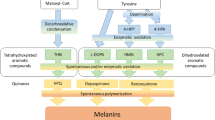Abstract
Heterokaryons ofNeurospora crassa were generated by transformation of multinucleate conidia of ahistidine-3 auxotroph withhis-3 + plasmid. In one of the transformants, propagated on a medium with histidine supplementation, a gradual but drastic reduction occurred in the proportion of prototrophic nuclei that contained an ectopically integratedhis-3 + allele. This response was specific to histidine. The reduction in prototrophic nuclei was confirmed by several criteria: inoculum size test, hyphal tip analysis, genomic Southern analysis, and by visual change in colour of the transformant incorporating genetic colour markers. Construction and analyses of three-component heterokaryons revealed that the change in nuclear ratio resulted from interaction of auxotrophic nucleus with prototrophic nucleus that contained an ectopically integratedhis-3 + gene, but not with prototrophic nucleus that containedhis-3 + gene at the normal chromosomal location. The growth rate of heterokaryons and the activity of histidinol dehydrogenase—the protein encoded by thehis-3 + gene-remained unchanged despite prototrophic nuclei becoming very scarce. The results suggest that not all nuclei in the coenocytic fungal mycelium may be active simultaneously, the rare active nuclei being sufficient to confer the wild-type phenotype.
Similar content being viewed by others
References
Barry E. W. 2002 Spore killer sensitive isolates become the killers in heterokaryons.Fungal Genet. Newsl. 49 (suppl.), 19.
Burnett J. H. 1976Fundamentals of mycology, chapter 16. Edward Arnold, London.
Creaser E. H., Bennett D. J. and Drysdale R. B. 1967 The purification and properties of histidinol dehydrogenase fromNeurospora crassa.Biochem. J. 103, 36–41.
Davis R. H. 1960 Adaptation in pantothenate-requiringNeuro-spora. II. Nuclear competition during adaptation.Am. J. Bot. 47, 648–654.
Davis R. H. 2000Neurospora: contributions of a model organism. Oxford University Press, New York.
Flint H. J., Tateson R. W., Barthelmess I. B., Porteous D. J., Donachie W. D. and Kacser H. 1981 Control of flux in the arginine pathway ofNeurospora crassa. Modulations of enzyme activity and concentration.Biochem. J. 200, 231–246.
Griffiths A. J. F. 1998 The kalilo family of fungal plasmids.Bot. Bull. Acad. Sin. 39, 147–152.
Grigg G. W. 1960 Phenotypic lag inNeurospora.Heredity 14, 207–210.
Legerton T. L. and Yanofsky C. 1985 Cloning and characterization of the multifunctionalhis-3 gene ofNeurospora crassa.Gene 39, 129–140.
Loo M. 1976 Some required events in conidial germinationof Neurospora crassa.Dev. Biol. 54, 201–213.
Maheshwari R. 2000 Microconidia ofNeurospora crassa.Fungal Genet. Biol. 26, 1–18.
Newmeyer D. 1984Neurospora mutants sensitive both to mutagens and to histidine.Curr. Genet. 9, 63–74.
Perkins D. D., Radford A. and Sachs M. S. 2001The Neuro-spora compendium. Academic Press, San Diego.
Pitchaimani K. and Maheshwari R. 2000 Phenotypic lag in microconidia ofN. crassa his-3+ transformants and its implication in estimation of nuclear ratios.Fungal Genet. Newsl. 47, 89–91.
Pittenger T. H. and Brawner T. G. 1961 Genetic control of nuclear selection inNeurospora heterokaryons.Genetics 46, 1645–1663.
Raju N. B. 1984 Use of enlarged cells and nuclei for studying mitosis inNeurospora.Protoplasma 121, 87–98.
Rao P. N. and Johnson R. T. 1970 Mammalian cell fusion: studies on the regulation of DNA synthesis and mitosis.Nature 225, 159–165.
Ryan F. J. 1946 Back-mutation and adaptation of nutritional mutants.Cold Spring Harbor Symp. Quant. Biol. 11, 215–227.
Ryan F. J. and Lederberg J. 1946 Reverse mutation and adaptation in leucinelessNeurospora.Proc. Natl. Acad. Sci. USA 32, 163–173.
Schroeder A. L., Inoue H. and Sachs M. S. 1997 DNA repair inNeurospora. InDNA damage and repair, Vol. 1, DNA repair in prokaryotes and lower eukaryotes (ed. J. A. Nickoloff and M. F. Hoekstra), pp. 503–538. Humana Press, New Jersey.
Serna L. and Stadler D. 1978 Nuclear division cycle in germinating conidia ofNeurospora crassa.J. Bacteriol. 136, 341–351.
Author information
Authors and Affiliations
Corresponding author
Rights and permissions
About this article
Cite this article
Pitchaimani, K., Maheshwari, R. Extreme nuclear disproportion and constancy of enzyme activity in a heterokaryon ofNeurospora crassa . J Genet 82, 1–6 (2003). https://doi.org/10.1007/BF02715873
Received:
Issue Date:
DOI: https://doi.org/10.1007/BF02715873




